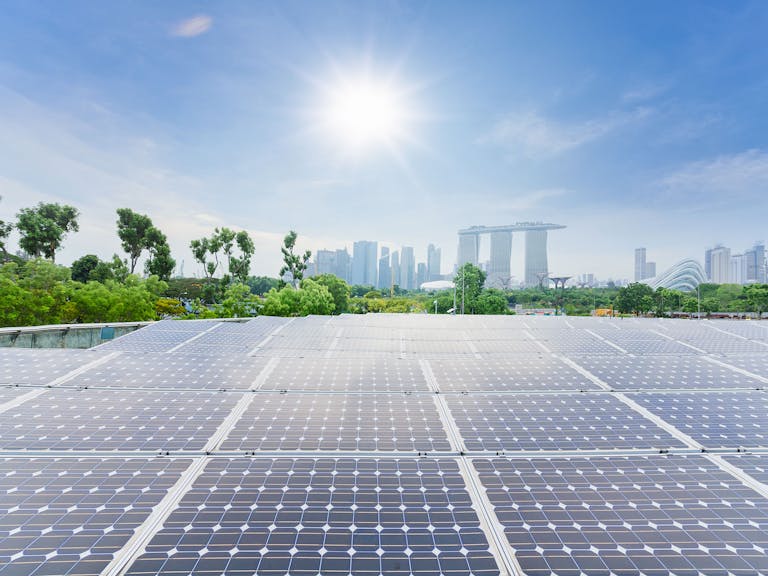
Sustainability
Environmental footprint management
Learn how AXA coordinates a network of dedicated environmental managers and ambitious environmental performance targets to reduce consumption and emissions across our business.
AXA, as a responsible company, is committed to addressing climate change through its core operations. Since 2012, an environmental management system has been in place, which includes an annual reporting of Group CO2 emissions from energy consumption, car fleet and business travel. Additionally, water consumption, paper consumption, waste production and recycling are also monitored.
AXA’s environmental footprint is published in AXA’s Universal Registration Document (URD) under Chapter 4: Sustainability.
In 2020, the Group renewed its commitments by setting an additional carbon reduction target and committing to offset the remaining emissions.
In 2023, in order to comply with GHG Protocol recommendations, AXA revised its calculation methods, resulting in a restatement of historical data (mostly disassociation of scope 3 emissions linked to energy, updated emissions factors for business travel).
Between 2019 and 2023 AXA’s own operations GHG emissions decreased by 34% (related to energy consumption, business travel, car fleet, and IT equipment and services).

In 2023, AXA’s total energy consumption was 223,638 MWh, including 126,199 MWh of renewable energy and 97,484 MWh of non-renewable energy. AXA also achieved reductions in non-energy consumption, such as water and waste.

AXA’s environmental targets
As part of its new AXA for Progress Index, AXA Group has set for its own operations as an exemplary company the target to contribute to Net-Zero by 2030, i.e. reducing by 50% its GHG emissions related to energy Scope 1 and 2, car fleet and business travel compared to 2019, and offsetting the remaining emissions with high quality carbon credits.
AXA’s GHG emissions reduction target is based on the approach promoted by the Science Based Targets (SBT) initiative, which AXA joined in 2015. To achieve its new AXA for Progress Index Net-Zero 2030 target, using the Absolute Contraction
approach with a 2019 baseline, AXA focuses on reducing its scope 1 & 2 (energy and car fleet) and scope 3 (business travel) emissions as follow:

AXA has been measuring its digital activities’ carbon footprint since 2020
Digital activities have a significant environmental footprint due to the extensive use of energy and raw material required to build increasingly sophisticated devices.
In 2020, AXA initiated a Digital Sustainability
program led by AXA Group Operations, with Corporate Responsibility team support, covering all AXA entities. This program aims at measuring the carbon footprint of AXA’s digital activities, considering the different components (usage, equipment, data centers and services) in a holistic way.
AXA’s operations have been contributing to carbon neutrality since 2020
Along with its commitment to reducing the carbon footprint of its own operations, AXA compensates for the remaining emissions each year by purchasing carbon credits.
By offsetting the 2020 GHG emissions related to energy, car fleet, business travel and IT equipment and services, AXA Group’s operations have been carbon neutral on this perimeter since 2021.
To compensate the full year 2023 carbon footprint of this scope (150,458 tCO2 eq). AXA Group selected 5 projects:
- Biogas development in China: the project supports nearly 1 million low-income rural Households with advanced biogas digesters and smoke-free biogas cooking stoves;
- Solar power project in Morocco: this project is expected to supply an annual average of 699,000 MWh of clean electricity to the Moroccan power grid, helping to avoid the power that would otherwise have been generated by fossil-fueled plants;
- Conhuas, restoring the Mayan Jungle of Calakmul, Mexico: Conhuas is a community-based project located in an area with high biological diversity of ecosystems;
- Laguna Om, restoring the Mayan Jungle of Calakmul, Mexico: Laguna Om is a community located between two large biosphere reserves. The project aims at promoting forestry and land use;
- San José del Rincon, Mexico: this community-based project aims at improving forest management practices.
Offsetting its own operations’ CO2 emissions enables AXA to meet the expectations of both internal and external stakeholders. Combined with emissions reduction efforts, this approach helps drive energy efficiency initiatives and promotes change in the management of facilities, car fleet, business travel and IT equipment and services. To achieve these goals, AXA engages not only its employees but also its suppliers in finding less carbon-intensive solutions. Additionally, offsetting helps prepare for potential GHG regulations, tax increases or rising energy prices.